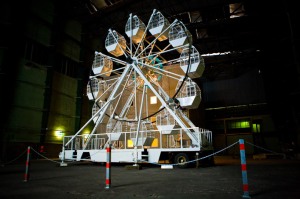I was not disappointed.
My
expectations were high. I came all the way from Bergen
just to listen and experience. And I am happy I did.
First I listened to
the talk on Friday.
About his interest in dance as an activity that does not produce material products (which he considers problematic because one cannot engage with them). Inter human communication is much more interesting, Sehgal says. And he does not want his works to be documented (to be made into material products) because one has to experience them first hand. The quality of the experience, says Sehgal, is more important than access to information about it.
When I came back to
experience "This Progress" on Saturday, I understood better his aversion towards documentation. Until then, I had just read about his work and seen a few illicit photographs of it. What I had read and seen made me very interested in its conceptual aspects, but having experienced "This Progress" live, I realise that the gap between contemplating his concept intellectually and actually experiencing it is much wider than it is in the instance of object based conceptual works, like Joseph Kosuth's "One and Three Chairs":
 |
| Joseph Kosuth, "One and Three Chairs", 1965. Photo from MoMA. |
Elsewhere in this blog I have stated that what I enjoy most about art is the way it can alter my perspectives. A painting, a photograph or a video can make me think, feel and understand something in a different way than a factual text can do. But that kind of interaction with a material work is very dependent on my own initiative and thus limits itself to my projections of meaning. For instance, Joseph Kosuth's "One and Three Chairs" cannot ask me questions that I myself do not think of while standing in front of it.
Tino Sehgal's "This Progress", however, can (on a very literal level) ask me questions, and that is exactly what it does.
As I entered Kunstnernes Hus on Saturday, a young girl (11 years old?) came over to me and said "This is a work by Tino Sehgal." Thinking about it now, that statement itself induces many questions: What is the work? Is it you? Is it you talking to me? Is it me answering you? Well, I did not think about all this then, because I had to focus on the question she actually asked me: "What is progress?"
From there on, the piece could have taken many directions. I could have decided that this was not something I wanted to take part in, or I could have given a nonsensical answer and thus sabotaged (?) the intention behind the work, but either way I would have already become a part of it.
Nice and clever as I want to be, I tried my best to give as good an answer as possible using terms that I thought the young girl would understand. And strolling through one of the downstairs galleries at Kunstnernes Hus with this sympathetic young girl was very enjoyable, even though I was slightly distracted by self-conscious thoughts about being partially responsible for the execution of the work ...
But I warmed up quickly enough, and really got going when I was handed over to a young man (around 20) who asked me how I have experienced progress in my own life. He took me up the back stairs to one of the second floor galleries, and there I was handed over again, to a woman (around 40) who listened patiently to a couple of stories I told her as an answer to her statement that people should not keep cats or dogs as pets ... By the time I had to leave (the man (around 60) who was the last one I talked to was told by Sehgal that he had to go talk to somebody else), I had really taken advantage of the chance to just ramble on ...
When it was over, I sat down for some lunch to digest the experience.
I thought about the interpreters (the people who talked to me): How demanding it must be to stay present and attentive towards so many different people throughout the day! Do they consider the conversations rewarding or just hard work? How much are the conversations really worth as constructive interaction, and how much are they "tainted" by the excitement inherent in the situation (the thought of being a piece of art ...)?
Well, while I was sitting there in the ground floor restaurant looking out at the beautiful winter sun on the trees and snow across the street, I nourished a very good feeling: I was moved by the interaction itself, - the simple beauty of meeting four people I newer knew, in a setting that in its strict limitations became liberating. When else do I get to talk to complete strangers about important matters without having to wonder about their agenda, the impression they have of me, etc.?
I was tempted to go again, to try once more. But I decided I had had my chance, and I was afraid the experience might be watered down a second time. It would perhaps have been interesting, though, to see what would be different if other "interpreters" had taken me around, or if I had come on a day that was not the busy opening day. (Jerry Saltz did five rounds of "This Progress" at the Guggenheim and managed to
make the artwork cry ...)


























.jpg)






